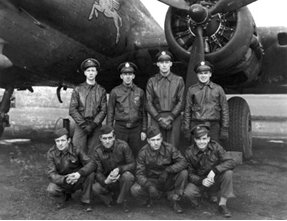|
The
Second raid on Schweinfurt (also called Mission 115) took place
during the Second World War on the 14th of October 1943, when 291
B-17's of the USAAF attacked ball bearing factories in
Schweinfurt, Germany. The factories had previously been attacked on the
17th of August resulting in a disastrous loss of aircraft. Some
42% of Germany's ball bearings were produced at Schweinfurt and were
considered so important to the German war effort that they were one of
the highest priority targets after aircraft factories and petroleum
production. The second mission to destroy the factories, which was
carried out on the 14th of October 1943, has become known as Black
Thursday in Air Force history due to the heavy loss of men and
aircraft. For hundreds of miles inbound to the target area, the B-17
bomber formations were attacked again and again by large numbers of
Luftwaffe fighters. A Spitfire escort protected the aircraft over the
English Channel. They handed over to fifty P-47's who accompanied
the raid as far as possible. Over Walcheren twenty BF 109's
attacked the escort fighters. German losses were five destroyed and four
damaged while no U.S. planes were lost. At Duren , thirty FW-190's
attacked the bombers. Another twenty Fw-190s later joined the attack.
During this battle, several B-17s were lost, as well as at least one
P-47. German losses were six Fw-190s. At this point, the Thunderbolts
had reached the limit of their range and had to return home. German
attacks on the bombers continued during the next three hours as the
B-17s flew without Allied fighter escort to the target. Despite the
spectacle of plane after plane falling, those bombers still able to fly
maintained their course. Crews had been told to expect seven minutes of
exposure to 500 flak guns while over the target area. Unusually, some of
the German attackers flew through their own flak to attack aircraft
which had not yet dropped their bombs. Only 229 planes reached the
target. The 305th Group lost thirteen of the fifteen bombers it sortied
and was effectively wiped out. After "Bombs Away," the
American bombers turned away from the target and headed for England and
their bases. Almost immediately the German fighters, having landed,
refuelled and rearmed, struck again. Finally, the B-17s reached the
coastline of Europe and relative safety, some of them so heavily damaged
that though they brought their crews home, they would never fly again.
Gunners aboard the bombers claimed to have shot down 138 German planes;
German records state only thirty eight were lost. In the final tally,
fifty-nine Flying Fortresses were shot down over Germany, one ditched in
the English Channel on the return flight, five crashed in England, and
twelve more were scrapped due to battle damage or crash landings (more
by AA-guns than by fighter aircraft), a total loss of seventy seven
B-17s. 122 bombers were damaged to some degree and needed repairs before
their next flight. Out of 2900 men in the crews, about 650 men did not
return, although some survived as POWS. Five were killed and forty three
wounded in the damaged aircraft that made it home, and 594 were listed
as Missing in Action. Only thirty three bombers landed without damage.
One U.S. fighter pilot was killed in a crash landing in England; and one
was wounded and bailed out over Duren. He was smuggled out by the
Resistance, returning to England three and a half months later. The
Allies learned the importance of a fighter escort with sufficient range,
recognizing the vulnerability of heavy bombers against interceptors.
Such very heavy losses could not be sustained, and unescorted daylight
bomber raids deep into Germany were suspended until 1944. Raids on
Schweinfurt resumed in February, 1944 during what came to be known as
Big Week with p-51 fighters escorting the American heavies all the
way to and from the targets.
|

